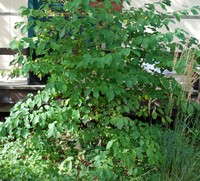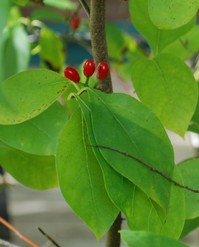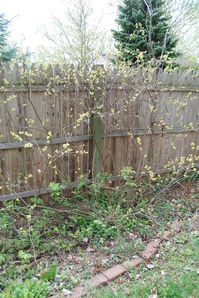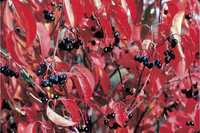Native shrubs make nice additions to your yard

My teenage Spicebush (Lindera benzoin) - about 5 feet tall
Rick Meader | Contributor
But, the world of native plants extends upward from there, to taller, longer lasting plants like shrubs and trees. In landscaping (and in the natural world), designs usually include three layers - the ground story, the understory (shrubs and small trees) and trees (canopy trees and taller evergreen trees). Of course, there are ranges of heights within each story, and some herbaceous plants may actually be taller than some shrubs, but it’s a useful guideline to follow.
Today, we’ll talk about some native shrubs that might be nice alternatives to non-native shrubs that are heavily used in landscapes.
Spicebush (Lindera benzoin) is a nice, non-threatening shrub that has been called our native forsythia since it blooms about the same time as forsythia and has yellow flowers. But that’s about as close as the comparison lasts, as they have very different leaves and forms.
Spicebush grows to about 8-12 feet tall, in a loosely pyramidal shape. It leafs out after the flowers have finished blooming so the delicate little flowers spread out along the stem show up very well on the bare branches. The leaves are about 4-6” long and sort of oval in shape and turn a lemon yellow in the fall, giving you another burst of yellow. When fertilized, the flowers develop into bright red berries on female plants in late summer/early fall that have a very nice scent when crushed (so do the leaves, and the twig when scraped).

Spicebush berries and leaves, just before turning yellow
Rick Meader | Contributor
It gets its name from that scent, and from the colonists’ use of the dried berries as a substitute for allspice. The University of Michigan Ethnobotany website lists 32 uses by Native Americans of the plant, ranging from a cold cure, to a treatment for female problems, to flavoring opossum and groundhog. Truly a miracle plant! In addition to all of this, it is host to the Spicebush Swallowtail butterfly, whose caterpillars eat the leaves. Although it is found naturally in and around wetlands, the spicebush I have has done quite well in the dry partial shade I’ve offered it. I highly recommend this shrub as a nice addition to any yard.
Another native shrub that I really like is Fragrant Sumac (Rhus aromatica). A cultivar of this shrub, Gro-low, has gotten a lot of use lately, even in fairly designed situations, such as the islands of the Oak Valley branch of the Ann Arbor District Library, or the Scio Township offices on Zeeb Road, because it stays low (only about 2-3’ high) and spreads to cover an area pretty densely. Here is a good website with some detailed photographs of fragrant sumac. If you have a spot for a shrub with an open, spreading character that can reach about six feet in height, the straight species is a good one. Its open character lets dappled sun get through to the ground so some plants can do well under it. It is called fragrant sumac because its leaves have a very nice aroma when crushed.

The open character of a blooming Fragrant sumac (Rhus aromatica)
Rick Meader | Contributor
The final shrub for this week is Nannyberry (Viburnum lentago). I don’t know where it gets its name, but I can tell you that if you eat the berry, its flavor won’t remind you of any delicious, sweet concoctions your nanny used to make. It’s not tasty, in my opinion, but it is edible, supposedly. It has large clusters of little white flowers that bloom in May, but what really makes this shrub special in my mind is its spectacularly colored leaves in the fall. They turn a brilliant red that will turn heads. The shrub is usually found in and around wet areas, is somewhat vase-shaped and can reach heights of 15-20’, so you can easily put a nice understory plant or ground cover at its base. As I mentioned in an earlier entry, there is a huge Nannyberry at the lower end of the Nichols Arboretum Main Valley that is worth visiting.

The brilliant red leaves and black berries of Nannyberry (Viburnum lentago)
Photo by D.E. Herman, USDA-NRCS PLANTS Database / North Dakota tree handbook. USDA NRCS ND State Soil Conservation Committee; NDSU Extension and Western Area Power Administration, Bismarck.
All of these shrubs would be good additions to your yard, given the right situation, and all will provide food and roosting spots for a variety of wildlife and beauty to your yard.
This week, the natives that are blooming in my yard include White trillium, Rue anemone, Canada anemone, Wood phlox, Graceful sedge, Carrion flower, Early meadow rue, Jack-in-the-pulpit, Golden Alexander, Spring beauty, Violets, Yellow violets, Bellwort, Redbud, Spicebush, Fragrant sumac, Wild strawberry and Virginia bluebells (for possibly the last week).
Get out and enjoy nature, everyone!
Rick is a local landscape architect with a special interest in all things natural, including native plants and the critters that eat them. You can contact him at yourland1824@gmail.com.

